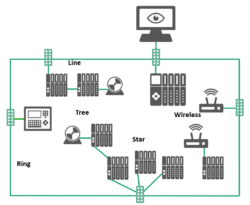Topology is a generic term to describe device connections in a network. The term is not exclusive to industrial networking. Social networks, for example, have their own topologies between people. Network topology, specifically, is the network layout. In Industrial networking, wired topology options include line, tree, star, and ring.
Topology Options
Fieldbus Networks
Line topologies are the most common configuration for fieldbuses like PROFIBUS. Users link each device to the next, resulting in a line configuration. Line topologies are typical in fieldbuses based on physical layers such as RS-232 or RS-485 because of their physical layer restrictions. Star or tree topologies are also possible in fieldbus networks, but they are less common.
Industrial Ethernet Networks
In networks based on Ethernet, like PROFINET, there is a variety of topology options: line, star, tree, and ring. Industrial Ethernet devices commonly have multiple ports with an integrated switch. Here, when connecting multiport devices in a line topology, devices receive Ethernet packets through one port and forward them through another as shown below.
Star or tree topologies are common in hierarchical networks and in-cabinet installations. Inside a cabinet, devices may be in close proximity. It doesn’t always make sense to connect them in a line configuration. Instead, star or tree topologies can be more efficient.
Ring topologies establish media redundancy. If a wire breaks in one section of the ring, there is a secondary connection to the network. Generally, Ethernet should not be connected in a ring without performing some network management. Without managing the ring, Ethernet packets can go in circles forever, using bandwidth. Some Industrial Ethernet protocols, such as PROFINET, provide resources to manage ring topologies. The topology diagram below shows an example of a ring topology. All the devices that make up the ring (highlighted in green) must be configured accordingly.
Learn more about topology options and PROFINET with this comprehensive White Paper:

